|
|
|
|
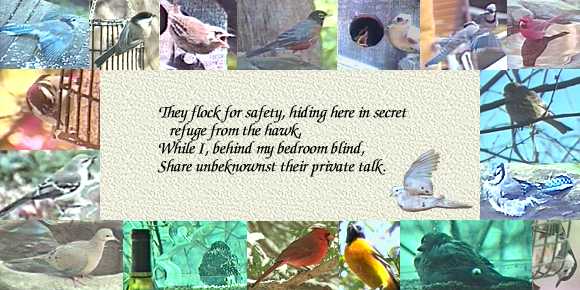
>
In order to obtain the images on these pages, I've created a bird area outside a large glass area of my bedroom. In front of the windows, I've set up a video camera. These images were captured from video tape. The video has been used in a set of music videos which made up the main body of my first TV program, "Naturally Wrentham." |
 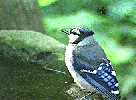
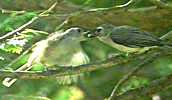 
 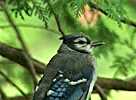

 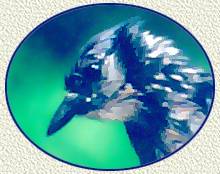 
 
 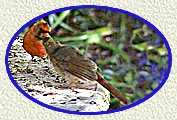

 
 |
|
Baby Blue Jay Begging
We've always had 4 or 5 blue jays coming to the feeders and when I saw the group expand by another four,
I decided that word of our cuisine had spread through the neighborhood. Pam Perry, a friend and
enthusiastic birder, looked at our guests and laughed, explaining that they were babies. It took a
while for me to recognize the shorter tail, fluffier chest and lack of sleekness in this group. When they
began spreading their wings and crying, I believed. Our tree became the local daycare. Early in the morning,
both parents and the babies would arrive. Soon after eating, the parents would disappear for awhile, leaving
the babies behind the safety of the arbor vitae screen. I watched them for hours as they bounced from limb to
limb. They were water babies from the start, enthusiastically sharing the birdbath and splashing one another.
This particular little one was trying out some dried bread on the platform feeder. It was obviously not
to his liking because he kept spitting it out and crying for someone to bring him something better.

Chickadee
The chickadees are very fast in and out of the feeders, so I'm always pleased when they stay long enough to get
on tape. They seem willing to eat out of any feeder and will eat any seed or suet. They'll grab a
sunflower seed,
fly to a branch, hold it between their claws and peck out the center meat, then fly back to the feeder for
another seed. I have never seen a chickadee baby and have never seen any bird nest in our tree, so I have
to assume that chickadees, like Athena, spring full-grown from Zeus. But they are loving creatures because
they seem to always come in pairs.

First Wren Baby Leaving Birdhouse
The babies began to show in the nest during the most brutal heat wave in Boston. I was determined to
tape the first baby emerging and so spent hours in the yard just feet from the birdhouse. At first,
the parents were annoyed at my presence but, with the hours, I became part of the scenery. A particularly wet
and sweaty part, I'll have to admit. To get as straight on a view as possible, I stood on the top of
our tallest ladder and leaned over to the camera, which was perched on a tripod with legs extended full
out, each leg sitting on the top of a large upside-down flower pot. I was very grateful that my husband
wasn't home to watch wife and camera teetering there. And during one interval between feedings that seemed way too long to
the starving baby wrens, one brave baby finally emerged and, with some difficulty, gained the perch. He
sat there for perhaps five minutes while his siblings stared out at him with eager interest. Finally, he began
fluttering his wings very fast and rose vertically to the roof of the birdhouse. As he reached the
roof, my battery died. The rest were gone in hours.

Robin
If I had been asked three years ago what birds were in our yard, I would have said robins. I came from
Chicago and that was the most obvious bird in my memory. In point of fact, I have seen very few robins
in our backyard. This one had just finished splashing himself in the birdbath. Unlike many of the birds
which arrive in pairs, our robin seems to live alone. There seems to be a major break between the
birds of the front yard and our backyard birds. There are crows on the telephone wires, but never
crows in our yard. A few doors down from us, two robins hop around the neighbor's grass. I'd like to
introduce our bachelor, but they don't seem overly social. I wonder if the houses are like the train
tracks and I wonder which is considered the better part of town in which to live.

Wren and Its Babies
We were thrilled when the pair of wrens began bringing twigs to the red house outside our window. I
finally understood the meaning of the name of our town, Wrentham. They were small and quick and
bright little birds, singing often and more loudly than their small size would imply. When they
stopped bringing twigs, we became convinced that there were eggs in the birdhouse and that we just
missed the changing of the guard. And then we noticed that two wrens were bringing twigs to the
second house in the yard. We finally went up on a ladder and peered into the first house. It was
empty. Reading up on wrens, we discovered that they will make claims on many locations to keep out
other birds. But, luckily, they did decide to settle down in our second house. It was wonderful
to watch them try over and over again to get forked sticks in through the small hole. They would
turn them around and around, occasionally dropping them, but usually succeeding. I had thought that
the depth of the house was for protection of the young but that seems to not be so. When the
babies had left the nest, we opened it up to clean it out. The twigs came up almost to the hole so,
although the babies would never drown if rain got in the house, it still seems that a predator
could have reached in a paw and caused damage. I'm still not understanding how the wren decides the
tradeoff of how high to build its nest.

Blue Jay Feeding Baby
The baby blue jays wanted to be fed for far longer than the parents wanted to feed them. It must
have been over a week that the jays would scream and flap at the sight of any adult jay. Occasionally,
they would be fed but often the jay would just turn away from the babies. I don't know if the babies
were being rejected by adult jays that weren't their parents, or whether the parents were just trying
to wean their demanding offspring.

Cardinal on Bath
We have one cardinal pair in the yard, never more. They're almost always together. I put out seeds
on several platforms, on the ground and in multiple feeders. The cardinals first choose the ground
food and then go to the feeders. Very rarely do they go to a platform. Of the feeders that are
appropriate to the cardinals, there is a hanging feeder with a bridge and a flythrough center area.
The squirrels have appropriated that one. The other is a "squirrel-proof" feeder (believe that and I
have a bridge we can discuss) with a weighted bar which comes down to cover the food when the weight is
too great. The only feeder the cardinals seem to ever use is the second one. This year, I watched the
male cardinal feed seeds to the female and recently the male has appeared in the tree followed by a baby
the color of a female cardinal. I have yet to get this on tape, to my everlasting frustration.

Sparrow
Sparrows seem to cluster in large flocks. Like most of our backyard birds, they are with us
throughout the year. Bushes against a house might not be good for the walls, but they're great for
watching birds in the winter when the leaves are gone. It took me a while to learn to tell a sparrow
from a finch (a finch flutters in midair like a hummingbird or a helicopter, and has a triangular
head like a dinasaur). The sparrows eat anywhere and anything -- except suet. I've never seen one
at a suet feeder. I haven't seen sparrow babies this year, but last year they followed their
parents everywhere, filling the tree with desperate hunger cries.

Bathing Blue Jay
Baby blue jays can't seem to stay out of the water. They bathe most mornings en masse. Unlike most of
the birds or babies that will fly away when I move at the window, jay babies just stare back dumbly and
then continue splashing. I'm not sure if that is arrogance of size or a trait that will not ensure their
eventual survival. When the babies first come to the water, they're very uncertain what to do. Eventually
they come down into the deeper part and just touch their chest to the water and jump back. After
convincing themselves that they live through the experience, they go in deeper and begin to splash
more enthusiastically. By the time they're done, they're soggy and fly up to a branch to dry off and
clean themselves up.

Nuthatch
It's hard to pass through a birdseed department of our local nursery without bringing home a new
birdfeeder. I think of this as virtuous because it makes the video footage more interesting. But I was
seduced by a nuthatch and woodpecker feeder. It was of cedar with a glass front and was filled with
raisins and nuts and made even me hungry. I couldn't quite believe it would work because I had only once
seen a woodpecker at the suet and had only recently seen nuthatches at Pam Perry's parents' home. But
I put up the feeder on a tree by the window. Within twenty-four hours, the neighborhood nuthatch pair
and a woodpecker had found it. I was ecstatic. I spent hours videotaping these happy birds eating their
little hearts out. And then I began videotaping the squirrels as they figured out how the top came off,
and then how to tilt the contents out. Eventually, I gave up filling the nuthatch feeder. The squirrels
were getting fat enough from the squirrel-proof feeder. But the nuthatches had been around long enough
now to learn where that feeder was and so they do come to visit, though they don't stay around as long
to eat and so don't get as much tape time as they used to.

Sleeping Sparrow
I tried putting up clear window feeders on several of the windows. It wasn't too successful when I
put them on windows that were easy to reach because the area in front of them were open. But when I
tried one on the kitchen window after crawling behind a bush, I hit the gold. In the winter, birds
line up in the branches waiting to get into the feeder. There will usually be 2 to 3 eating and a
few fluttering to try to scare those off. The feeder empties once a day, so I crawl through the snow
and bushes and fill it high over my head, as seed shells float down to cover my clothes. The first
time I saw a bird sitting in the feeder, I was afraid that it had frozen to death out there. It took
a little while to see that it was sound asleep, basking in the sun coming through the plastic roof.
The feeder seemed to have enough greenhouse tendencies to become the favored winter resort. That sparrow
was the first bird I saw sleeping in the feeder. It most certainly wasn't the last.

Oriole
I coveted a yellow bird. I had blue ones and red ones and I wanted a yellow one. But the first time
I saw our oriole, it was bashing itself against the kitchen window, right above the feeder. It was
pretty skittish and didn't like to come when I was anywhere nearby. Most of the birds get used to my
being there and eventually think of me as a kitchen appliance. It took a lot longer for the two orioles
to take me for granted. Eventually, I was able to get some good footage of both of them spread against the
glass. Pam Perry identified them for me as young males, so they were either fighting with their reflections,
or courting rather aggressively. The bush in front of the window is quince, and the orioles came with the
blossoms. I never knew that birds other than hummingbirds ate blossom nectar before that. Last year
I tried feeding them a banana. That worked much better than the orange or the apple. This year, the
orange had better results. The window, however, is a mess.

Cardinal in Tree
When visiting Pam's parents home, I was awed by the number of cardinals there. Beyond the yard is
a corridor between two walls of pine that goes into the distance. Pam's father described the trees in
winter covered with snow and spotted with red cardinals and blue jays as though ornamented for the season.
I have but one cardinal pair but he is magnificent against the snow-covered arbor vitae.

Sleeping Starling
Flocks of grackles and starlings eat in our backyard in winter. I always heard that starlings were dirty
birds. Whoever said that obviously hasn't watched a starling bathing. They bathed every day in the
heated birdbath. It only took one mass bath for the shallow dish to be emptied by so many wildly fluttering
wings. For awhile after the kitchen feeder went up, the only birds to visit were small - the sparrows and
finches, chickadees and titmice. But one day I watched a flock of starlings fight for space at the feeder
and later that day came back to see that one had subcumbed to the warmth and had managed to fit inside and
fall asleep. I worried for the little birds that couldn't get to the food. I shouldn't have worried. A
short while later I passed the kitchen again and there, squeezed against the window, was a sparrow, busily
eating behind the sleeping starling.

Mourning Dove
I thought at first that mourning doves were pigeons. This summer we've added two pigeons to our backyard birds
and I see why Pam laughed at me. Doves are smaller, and their soft cries make them seem gentler. In the middle
of the heatwave last summer, all the birds were desperate. But the doves seemed to have the best ideas for
cooling off. Besides floating around in the birdbath as if they were in a children's pool, the
doves would raise up one wing at a time and let the sun hit their underwing. Pam explained that they were
letting the light kill the lice in their features. When the patio bricks were hot, the doves would lay
themselves out on the bricks, wings spread out as if they were dead. The only other bird I've seen do
that is the blue jay, who only spreads out on the garage roof.
Mourning doves are beautiful, but they aren't very bright. Soon after I bought a feeder just for the
squirrels, one of the doves found their way into it. The feeder was a large glass jar attached to
a covered hut with a center opening. One goes in and turns to get into the glass jar. This, like the
window feeder, should provide some extra warmth in winter. One of the doves was attracted to the
sunflower kernels and walked into the glass jar and began feeding. The sight of the movement inside
the jar attracted the attention of a squirrel which came over to investigate. The dove panicked but couldn't
figure out how to get out of the jar. The squirrel went into the opening and I thought we were going to
have a squirrel/dove fight on the spot so I ran to the yard, which scared off the squirrel. The dove got
a look at me and really started fluttering but couldn't seem to figure out how it got in originally. I
moved close to the class jar, away from the opening and that convinced the dove to figure out an exit
strategy, which it then accomplished in a swirl of feathers. Since then, though tempted, the feeder
remains the sole property of the squirrels.

Mockingbird
Since I see the world so much through the viewfinder of my camera, I sometimes begin to think it really
is just black and white. With the eastern mockingbird, that perspective works perfectly. I really
noticed the bird for the first time on video tape. It was sitting on the birdbath. Stilling the
videotape gave me time to look it up in the bird book. I've never seen two and I rarely see the one.
It never comes for food, only for water. I've noticed one perched near the street at the path where
I walk my dog. Pam seems to recognize it by its song. I can only hear that its song is longer
and different. By standing long enough, I can finally find it in a tree. But it's much easier when
it comes and sits in the open by the birdbath. Best investment of the whole area.

Woodpecker
For all the lovely birds in the yard, I probably get the most rush from the sight of a woodpecker.
I don't know why, possibly too many Woody Woodpecker cartoons as a child. Very, very rarely do I see
them actually pecking at a tree. When I do see a red head, it's at the suet feeder or at the nuthatch/woodpecker
feeder.



 Send mail to: maida@iment.com
Send mail to: maida@iment.com
 Copyright © 1996, Mary S.
Van Deusen
Copyright © 1996, Mary S.
Van Deusen